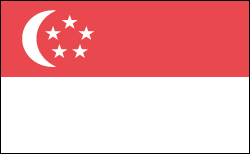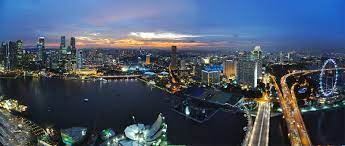The world is a busy place, with politics changing and events happening all the time. However, we make it simple to quickly read all the pertinent data for every country, in addition to flag details and an atlas summary for what kind of general information you are most interested in.
The following basic facts and information is covered in detail in each Country’s Profile:
Maps, geography, Brief history, the current ruler, area, population, capital, and largest cities – Languages-Race and ethnicity – Faith – Rate of literacy and The economy.
Facts & Information about Singapore
LetsExplore has everything you need to know about Singapore. Check out our country profile, full of essential information about Singapore’s geography, history, government, economy, population, culture, religion, and languages.
Flag Of Singapore

Map of Singapore

- President: Tony Tan Keng Yam (2011)
Prime Minister: Lee Hsien Loong (2004)
Land area: 241 sq mi (624 sq km); total area: 267 sq mi (692.7 sq km)
Population (2014 est.): 5,567,301 (growth rate: 1.92%); birth rate: 8.1/1000; infant mortality rate: 2.53/1000; life expectancy: 84.38
Capital and largest city (2011 est.): Singapore, 5,183,700.
Currency: Singapore dollar
Languages: Mandarin (official) 36.3%, English (official) 29.8%, Malay (official) 11.9%, Hokkien 8.1%, Tamil (official) 4.4%, Cantonese 4.1%, Teochew 3.2%, other Indian languages 1.2%, other Chinese dialects 1.1%, other 1.1% (2010 est.)
Ethnicity/race: Chinese 74.2%, Malay 13.3%, Indian 9.2%, other 3.3% (2013 est.)
Religions: Buddhist 33.9%, Muslim 14.3%, Taoist 11.3%, Catholic 7.1%, Hindu 5.2%, other Christian 11%, other 0.7%, none 16.4% (2010 est.)
Literacy rate: 95.9% (2010 est.)
Economic summary:
GDP/PPP (2013 est.): $339 billion; per capita $62,400.
Real growth rate: 4.1%.
Inflation: 5.2%.
Unemployment: 1.9% (2013).
Arable land: 0.89%.
Agriculture: orchids, vegetables; poultry, eggs; fish, ornamental fish.
Labor force: 3.444 million (2013 est.); agriculture 1.3%; industry 18.6%; services 80.1 (2013).
Industries: Chemicals, electronics, financial services, machinery for oil drilling, petroleum refining, rubber processing and products, processed food and drink, ship maintenance, building of offshore platforms, life sciences, and entrepôt trade.
Natural resources: fish, deepwater ports.
Exports: $410.3 billion (2013 est.): machinery and equipment (including electronics and telecommunications), pharmaceuticals and other chemicals, refined petroleum products, food and beverages.
Imports: $373 billion (2013 est.): machinery and equipment, mineral fuels, chemicals, foodstuffs, consumer goods.
Major trading partners: U.S., Malaysia, Hong Kong, China, Japan, Indonesia, South Korea, Indonesia, Saudi Arabia, UAE, Australia (2012).
Member of the Commonwealth of Nations
Communications:
Telephones: main lines in use: 1.99 million (2012); mobile cellular: 8.063 million (2012).
Radio broadcast stations: AM 0, FM 18 (2008).
Television broadcast stations: 8 (2008). Televisions: 1.33 million (1997). Internet Hosts: 1.96 million (2012). Internet users: 3.235 million (2009).
Transportation:
Railways: total: 38.6 km.
Highways: total: 3,425 km; paved: 3,425 km (including 161 km of expressways).
Ports and harbors: Singapore.
Airports: 9 (2013).
Geography
The Republic of Singapore consists of the main island of Singapore, off the southern tip of the Malay Peninsula between the South China Sea and the Indian Ocean, and 58 nearby islands.
Government Type: Parliamentary republic.
History
Between 2500 and 1500 B.C., people from the Malaysian peninsula and the island of Singapore initially settled in the region (see Malaysia). With the growth of the spice trade came increased interest in the area from the British and Dutch, and Sir Stamford Raffles established the trading station of Singapore in 1819. As the previous Straits Settlements colony was dissolved in 1946, it became a distinct Crown colony of Britain. The little island of Labuan was moved to North Borneo, while the other two communities on the peninsula, Penang and Malacca, joined the Union of Malaya. Christmas Island and the Cocos (or Keeling) Islands were given to Australia in 1958 and 1955, respectively.
After achieving complete internal self-government in 1959, Singapore’s prime minister was the authoritarian-leaning economic genius Lee Kwan Yew. Singapore became a member of the Federation of Malaysia on September 16, 1963, along with Sarawak, Malaya, and Sabah (North Borneo). On August 9, 1965, it declared its independence and left the federation. A month later, it became a republic.
Under Lee’s leadership, Singapore became one of Asia’s safest, cleanest, and most economically successful cities. However, some who claimed that Singapore’s success was attained at the expense of individual freedoms also criticized the country for its stringent laws requiring civic obedience.
When S. R. Nathan was confirmed as the lone candidate entitled to compete in the 1999 elections, he was proclaimed president without holding a vote. Since Singapore separated from Britain in 1965, Lee Hsien Loong was the nation’s third prime minister, having taken office in August 2004. In May 2006, Lee encountered his first electoral challenger. In the parliamentary elections, his People’s Action Party (PAP) secured 82 out of 84 seats.
The People’s Action Party, which had been in power in Singapore since May 2011, was reelected with a majority of 81 to 6, or 60% of the vote.
The opposition saw this percentage as encouraging because it was much lower than in the two previous elections. Prime Minister Lee Hsien Loong promised a more effective government in the future and, in an unusual move, admitted his shortcomings after the election.
The ruling party’s Tony Tan emerged victorious from a field of four candidates in August’s presidential election, which followed the general election. Tan was predicted to win, but his victory was by no means overwhelming—the 7,000 vote difference represented 35.2% of the total vote.

Leave a Reply